Valencia have undergone some incredibly turbulent form in La Liga in the past few seasons. Since the 2014/15 season, Los Murciélagos have managed to finish inside the top four on three separate occasions. However, they have finished in the bottom half of the table three times too, subsidised by one ninth-place finish.
The 2020/21 season, which came to a close just less than two weeks ago, was their worst in the last seven campaigns. Valencia finished 13th in the end and their terrible form led to the sacking of head coach Javi Gracia, the former Watford manager, just two weeks prior to the season’s conclusion. The Spaniard left with just a 29 percent win percentage before he was dismissed, an indictment on just how poor Valencia were.
However, preparations for the 2021 campaign have already begun as the board have appointed former Getafe coach José Bordalás as the manager on a two-year deal. Bordalás’ Getafe played a very dogged and aggressive pressing style, one which was effective but not very easy on the eye.
Nonetheless, the 57-year-old who was born in Valencia managed to guide Getafe from the Segunda Division back to the Primera in 2016/17 and then to fifth place in La Liga in 2017/18, the club’s highest-ever finish, qualifying for the UEFA Europa League where they reached the quarter-finals.
His appointment at Valencia is certainly interesting and one to keep an eye on. This article will be a tactical analysis of Bordalás essentially in the form of a head coach scout report. It will be an analysis of his tactics at Getafe and how he will implement his principles of play at Valencia.
Lineups, formations and, double fullbacks
Looking at the choice formation Bordalás has gone with throughout his time at Getafe, a sensible estimate would be that he will look to deploy a 4-4-2 formation with his new club. Getafe have used the conventional system in 68 percent of their matches this season alone in all competitions.
The 4-4-2 gives Getafe a lot of balance in their side due to the personnel but the formation is also mathematically the best for covering the full dimensions of a football pitch when defending, according to the former Milan and Atletico Madrid boss Arrigo Sacchi.
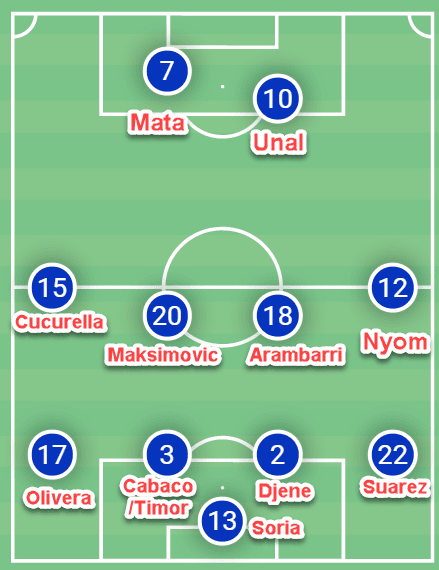
This was Getafe’s typical starting eleven from this season with the notable change coming at left centre-back where David Timor and Erick Cabaco were rotated quite a bit. The right-wing and right-back were also rotated but it was mainly rotated among both Damian Suarez and Allan Nyom with Nyom becoming the right-back at times and Suarez playing further forward.
Having two fullbacks as wingers has been a notable aspect of Bordalás Getafe over the years. This has allowed Getafe to be very efficient when defending the wide areas, but the four players wide-men are also skilled going forward too. On the left flank, Mathias Olivera and Marc Cucurella are utilised the same as Suarez and Nyom.
Essentially, which we will get into later, Getafe look to compact the central spaces in their 4-4-2 defensive block and force the opposition wide. As they have good defenders in the wide areas, they can defend this area of the pitch quite well.
Valencia will likely adopt this 4-4-2 formation. This season, Los Murciélagos have used the 4-4-2 system in 62 percent of their games and so the players have already been quite well-drilled in this shape. However, the use of the double fullbacks is quite unlikely because of the personnel available to Bordalás with his new side. He still may be able to use it on the right side though as opposed to the left side with Thierry Correia and Daniel Wass.
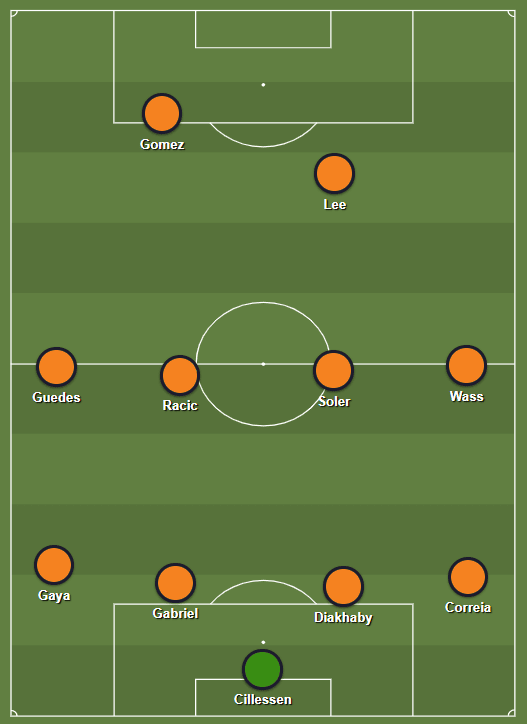
Here is how Valencia may lineup under Bordalás using their current crop of players. Of course, new signings will potentially come in during the summer window so the lineup may be more geared towards Bordalás’ vision.
This is merely just guesswork by looking at the profile of player the 57-year-old has preferred throughout his time with Getafe. Kevin Gameiro is another option he may choose to play up top or perhaps Goncalo Guedes will be deployed there as Gracia did in the past few months. Hugo Guillamon has been a major player for Valencia too so he may also find himself in the new manager’s starting lineup instead of Gabriel Paulista or Mouctar Diakhaby.
Attacking phase and long balls
Getafe, under Bordalás, were instructed to go long from goal-kicks and when the ball was in the first third of the field instead of trying to build their way out of the back using structured positional attacks.
In this sense, Bordalás is quite a pragmatist as he knew that his side at Getafe did not possess excellent ball players and so they bypassed the build-up phase by going direct to their centre-forwards. This does mean that Getafe had the third-least amount of passes in total throughout the 2020/21 La Liga season, with only Cadiz and Granada attempting fewer passes, but they also had the third-highest number of long balls played.
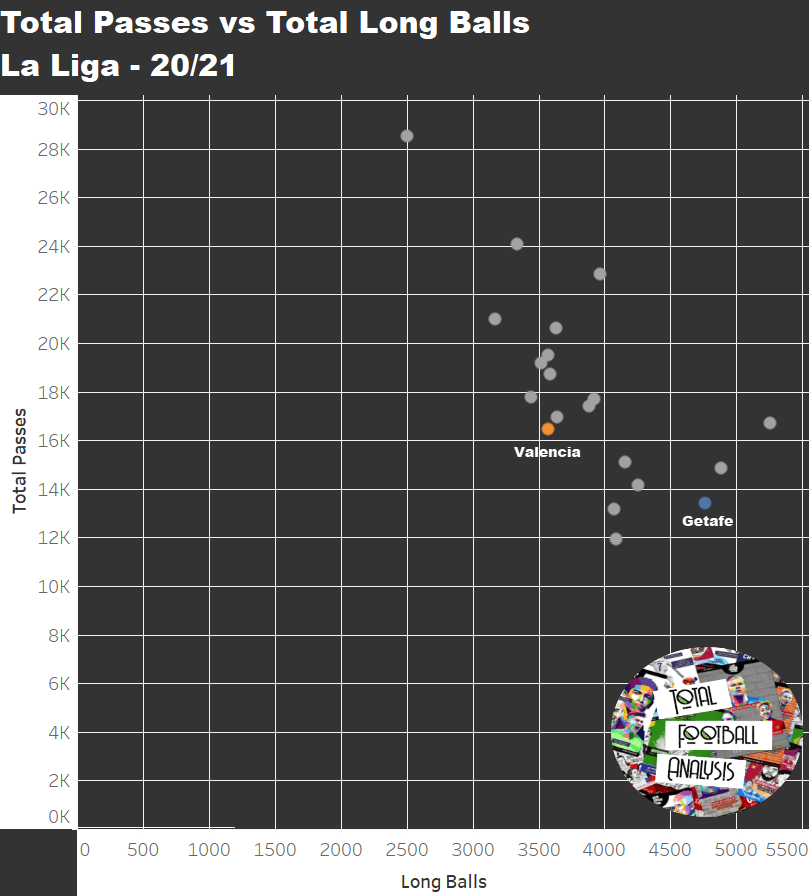
As we can see from this graph though, throughout the campaign which has just finished, Valencia have played the sixth-least amount of long balls in total and the seventh-least amount of total passes.
Valencia did play out from the back at times under Gracia but they also tended to go direct to Maxi Gomez up front when the opposition pressed high. It is likely that under the new manager, Valencia will drop lower in the graph by the end of next season in terms of total passes but will be even further along regarding long balls.
When going long from goal-kicks, Getafe pushed all of their outfield players to one side of the pitch and formed a 4-2-3-1-type structure. The aim was to play to one of the centre-forwards who would drop deep and look to flick the ball on, but they would also have at least one player running in behind and a few supporting players to win the second ball.
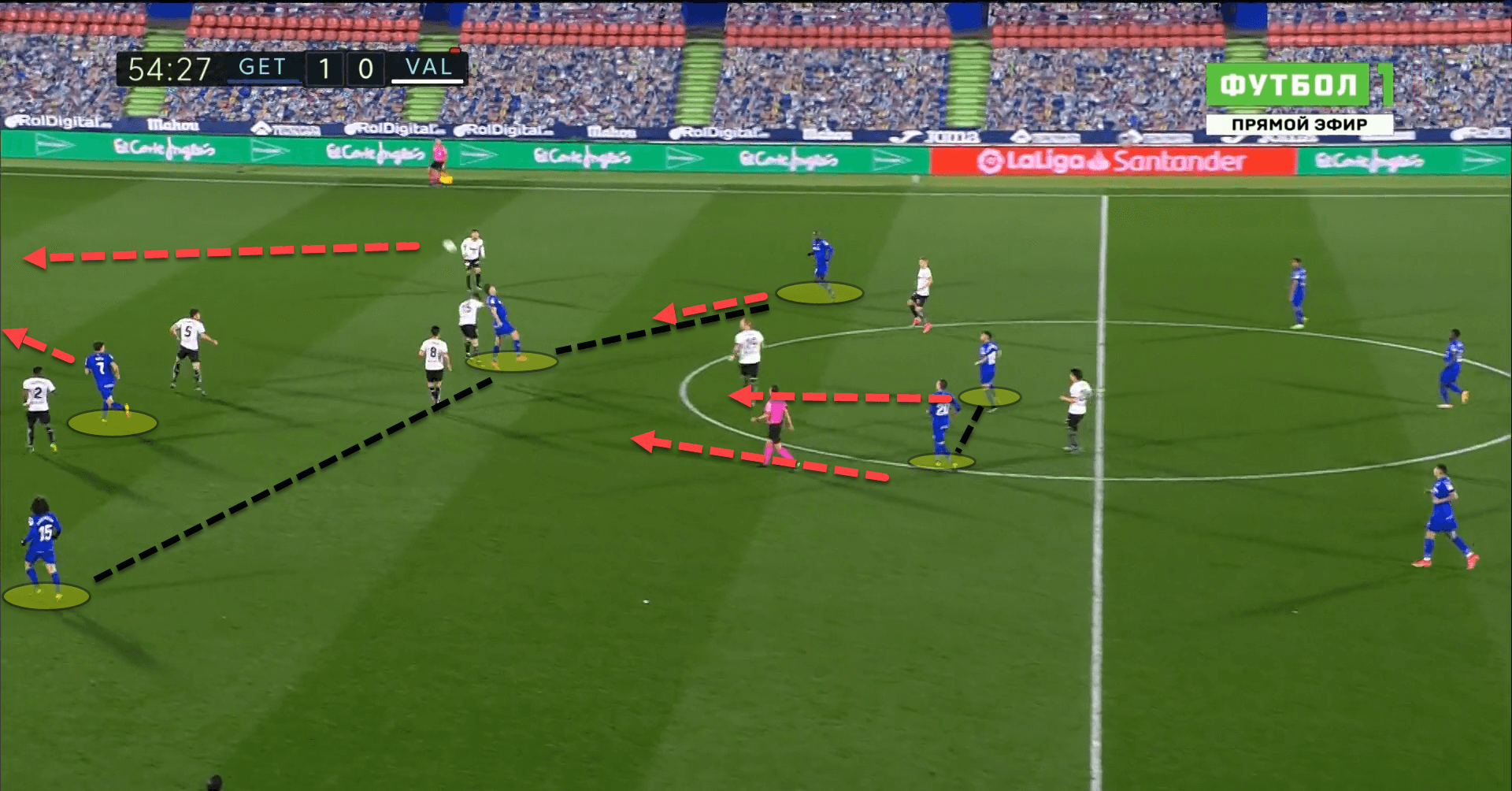
Bordalás’ Getafe used multiple long ball variants that are likely to be transferred to Valencia ahead of the new season. The image above shows how his side is set up when the ball is played down the middle of the pitch towards the strikers.
The most aerially prominent centre-forward drops short to drag out one of the centre-backs whilst his strike partner exploits the space in behind to feed off the flick-ons and potentially put himself through on goal. At least three players support the forward challenging for the aerial ball by ensuring that they are close to him in case he knocks the ball down. This gives Getafe a really good support structure to win the second balls in front and behind.
Another long ball variant used by Getafe this season is when the ball is played directly to the wingers. The idea here is to deploy wide players on the flanks who are aerially efficient to match up against the opposition’s fullback on that side. They can flick the ball onto the ball-near centre-forward who has made a darting run into the channel from this position.
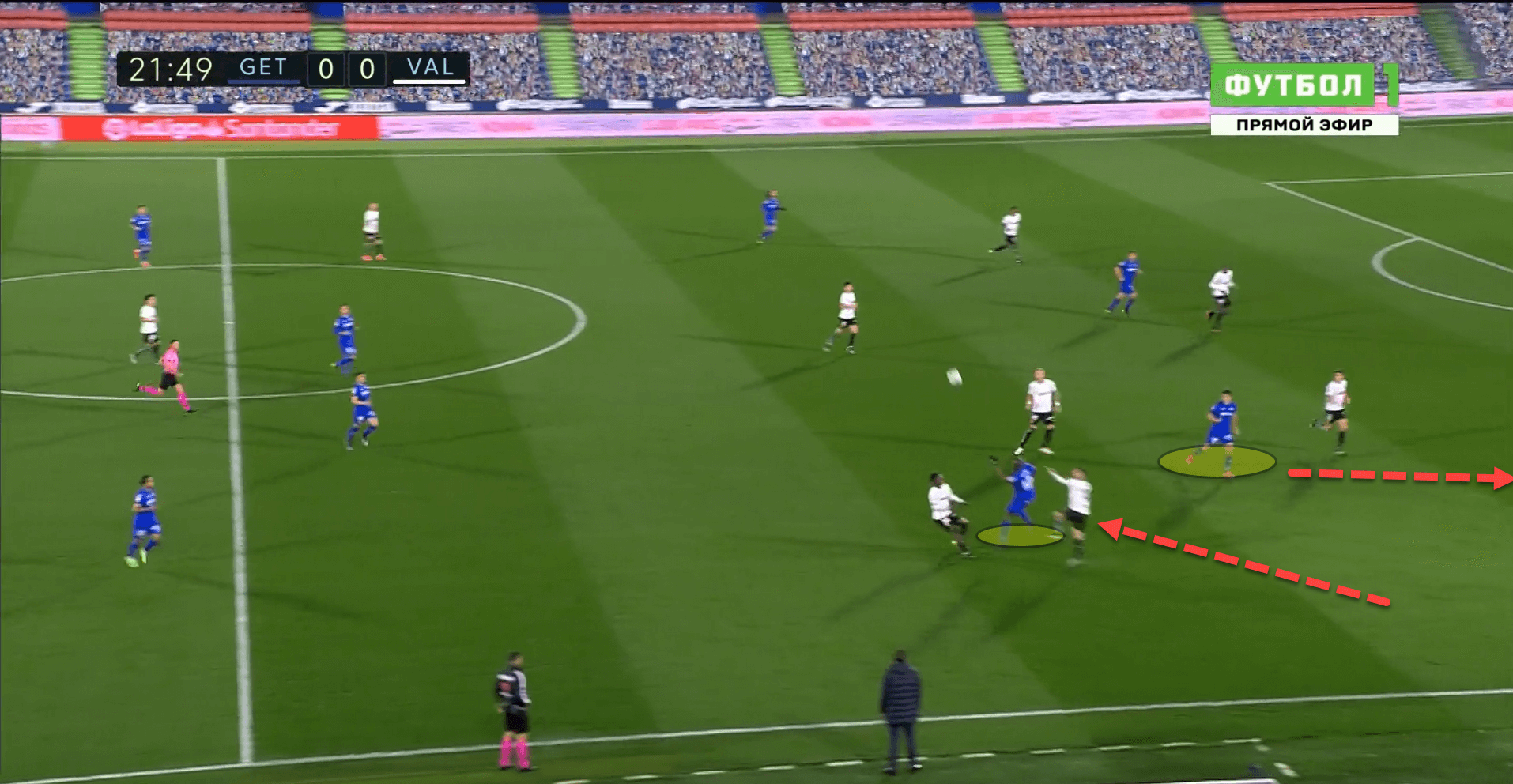
The structure here looks just like a wide 4-4-2. The ball has been played long towards the right flank to Nyom who has dropped deep to flick the ball on successfully to Jaime Mata who has made a run into the channel between the fullback and the ball-near centre-back as there is space there due to the fullback stepping out.
These variations are very useful to progress higher up the pitch and to bypass the build-up phase. Los Murciélagos could use this to great success under Bordalás due to the personnel available to the Spanish manager, particularly with the centre-forwards’ movements. Maxi Gomez, who is roughly 6ft 1, could be the forward who drops to drag the centre-back out due to his efficiency in aerial duels, while Goncalo Guedes could potentially use his pace to latch on to flick-ons in behind.
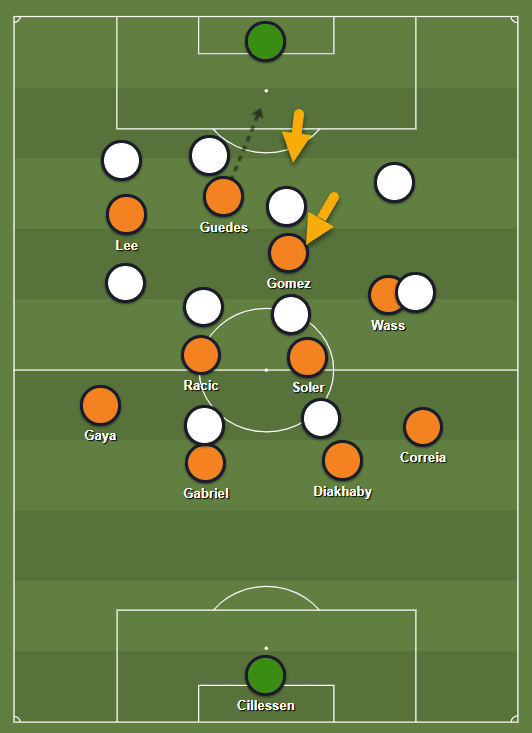
Although it is still very much up for debate who starts up front for Valencia next season, this strike partnership of Gomez and Guedes is certainly one for him to think about and could work extremely well in what will be a very direct side.
Chance creation methods and goalscoring statistics
A major area of concern with regards to Bordalás taking over as the new head coach of Valencia is his team’s lack of goals. Getafe were the lowest scorers in La Liga last season and were the ninth-lowest scorers in the division in the 2019/20 campaign despite a top-half finish.
In the season that has just ended, Bordalás’ men put the ball in the opposition net a total of 28 times in 38 matches which is a very low return. Not only this, but they also had the second-lowest total expected goals (xG) in the league meaning that the quality of chances they created was rather low too.
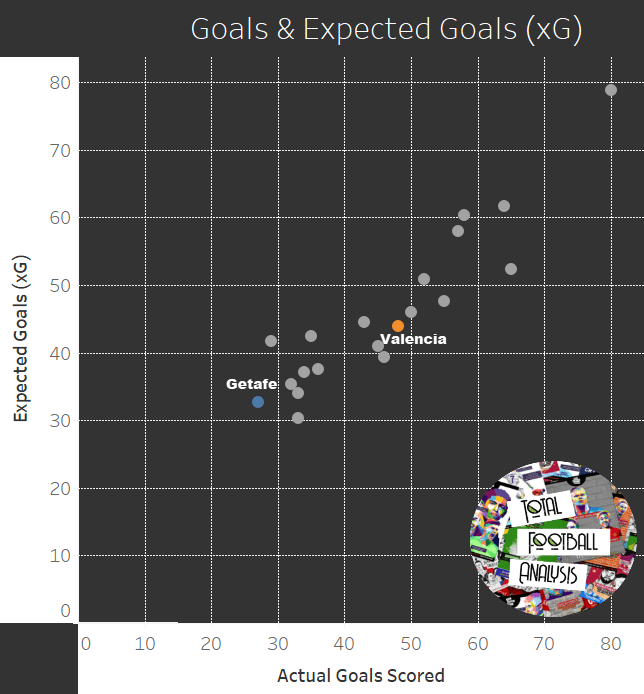
The worry of course would be that Valencia will drop off to these low levels under the guidance of Bordalás. Regardless of their abhorrent defensive record, Valencia were one of the strongest attacking units in the league last season whereas Getafe were the worst.
To add further fuel to their worries over the new manager, Valencia had the second-lowest xG per shot taken in La Liga last season with just 0.106 xG per shot. The lower the quality of the shot, the less chance it has of going into the net and being scored. The issue here is that if Valencia are still one of the league’s top scorers, but their shot quality is poor and it takes far more opportunities for them to score, what will happen when a more pragmatic manager comes into the club where it is likely that they will be shooting less?
Regardless, Bordalás likes his side to put crosses into the box as their main source of chance creation.
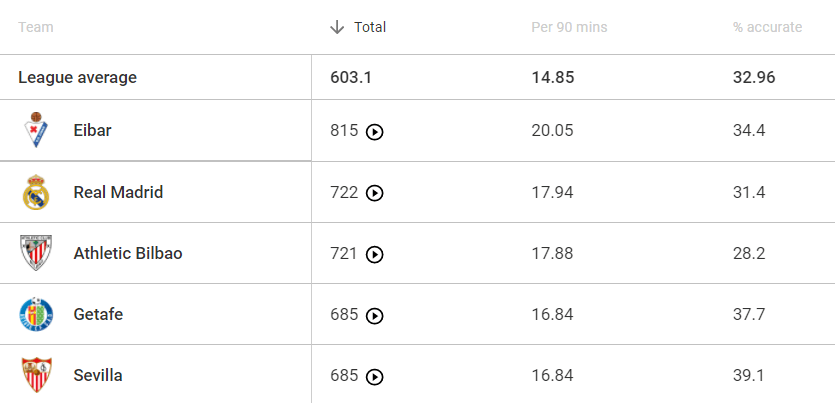
As can be viewed in the table above, last season Getafe put the fourth-highest amount of crosses into the box with 685, which was an average of 16.84 per game and an accuracy of 37.7 percent, one of the league’s highest.
Valencia were on the opposite scale of this interestingly enough and put the fifth-least number of balls into the box with an average of just 12.71 per 90. The accuracy of these crosses was also incredibly poor, standing at just 27 percent.
Much like the number of aerial balls played, the volume of crosses that Valencia will play next season is likely to take a steep increase. Having solid crossers of the ball such as Daniel Wass and aerially proficient centre-forwards like Gomez will make this a much easier process.
Nonetheless, let’s take a look at how Getafe manage to create space to put balls into the box to see just how it will be implemented at Valencia. Typically, Bordalás’ side overloads the opposition’s defensive line to make room for early crosses.
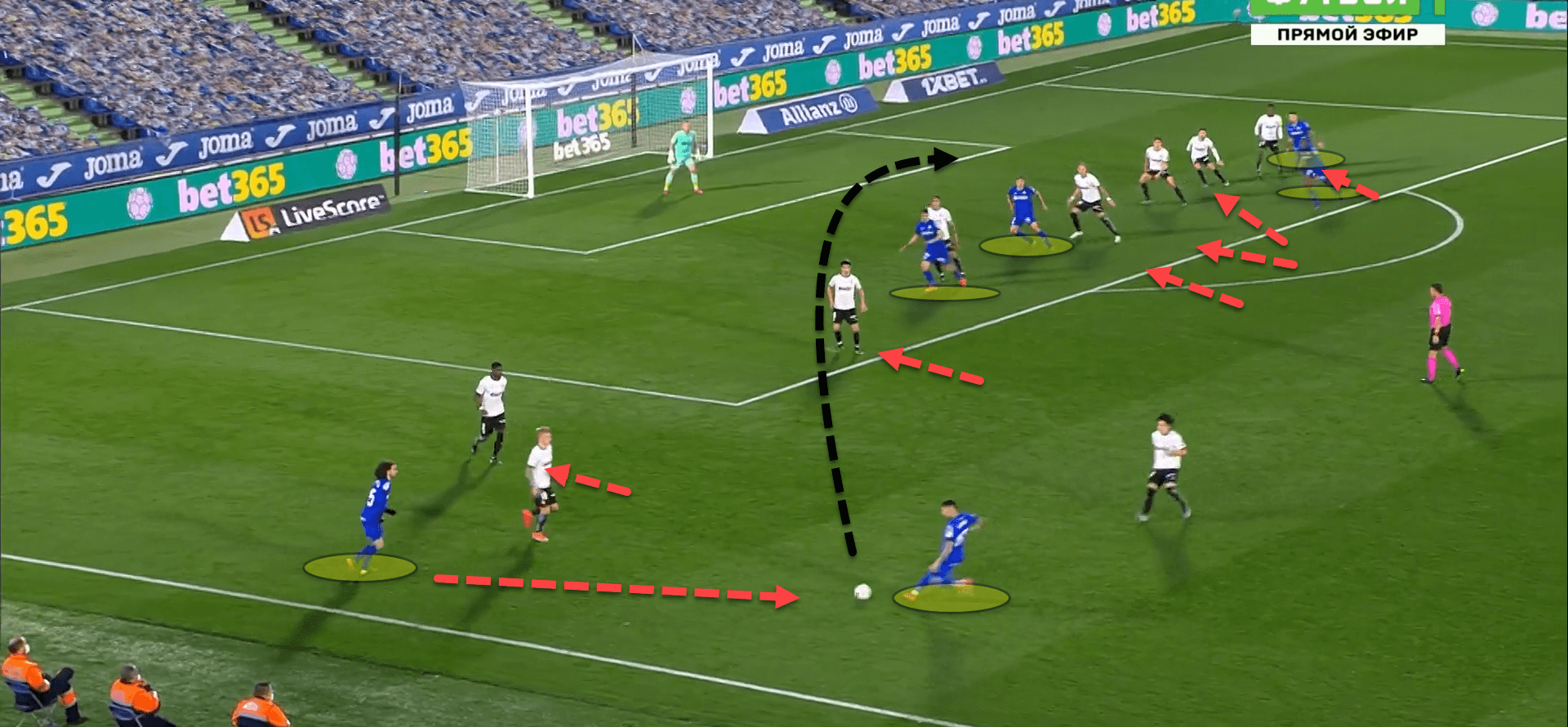
Here is an example of where Getafe have overloaded the last line of the opposition’s defence. By doing so, two things occur. Firstly, they have more players in the box to aim for and who are willing to attack the cross. But secondly, it pins the last line back and there is now more room at the edge of the box in the final third for a player to receive the ball in and cross.
In the image above, Getafe have overloaded the box, as already stated. From there Cucurella decides to make a dart down the left flank which drags two men to follow him and so the left-back, Olivera has space to receive the ball in and hit an early cross unchallenged which he successfully does, although the header was not converted.
Crossing, when utilised correctly, can be a very useful tool for any team, particularly for sides that thrive on physicality winning aerial balls such as Getafe. Under Bordalás in the new season, we will likely see Valencia become far more efficient from crosses.
Zonal defensive block
Although their attacking styles have differed quite a bit, one tactical aspect that the two clubs share is that they both defend in a zonal defensive block. Getafe presses a lot higher than Valencia though and Bordalás’ former side boasted a 9.72 Passes allowed Per Defensive Action (PPDA) this season, one of the lowest in the division.
In terms of PPDA though, the lower the number, the more an opponent presses as they allow their opponents to have less time on the ball. Valencia did not press as high or intensely and often opted to drop back into a 4-4-2 mid-block instead of trying to press when the opposition were in the build-up phase.
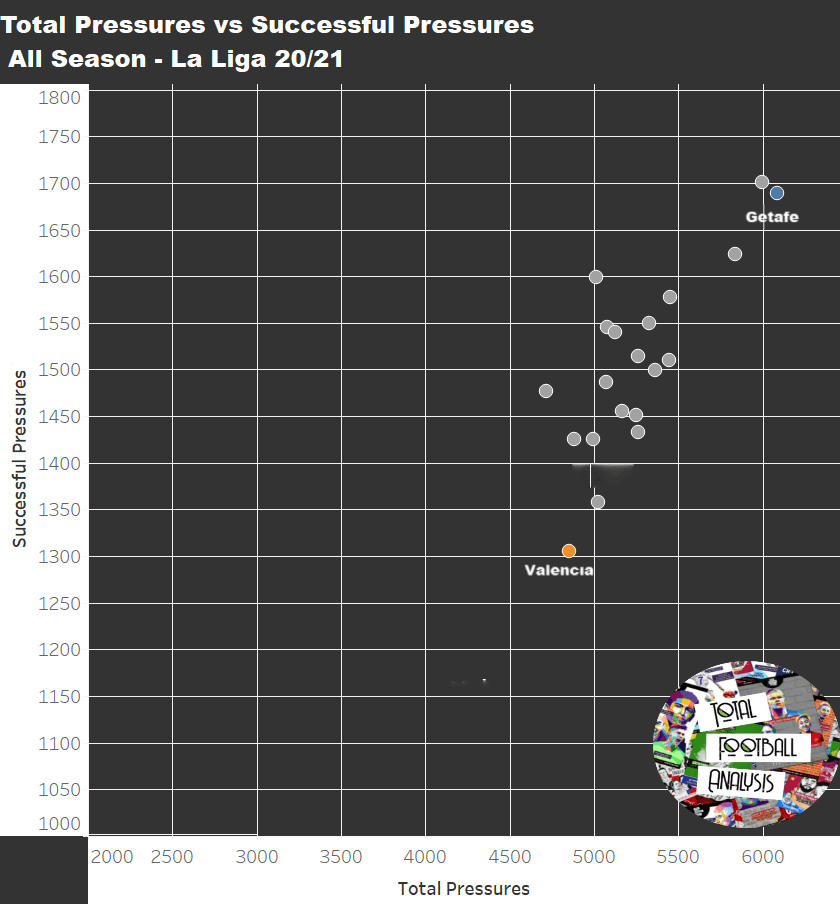
Looking at the graph above which measures the total amount of pressures applied by a defending team to the number of successful pressures completed, the differences between the two sides defensively are obvious.
When calculating pressures, it is not just when the defending team is pressing high. Pressures can happen when a team is sitting in a deep block too. It merely means that Getafe are far more active defensively than Bordalás’ new side. Valencia are worryingly low on this graph and the Spanish manager has serious work cut out for him when he begins pre-season training.
Looking at Valencia’s defensive record too, massive work is needed to shore up the team when they are in the defensive phases. Los Murciélagos had the eight-worst defensive record in La Liga this season, conceding 53 goals which is an average of 1.4 goals against per game.
What is arguably more worrying is that they accumulated a total of 65.75 expected goals against (xGA) throughout the season, the worst in La Liga.

On the flip side, Bordalás’ Getafe have an incredible record for a club that is constantly punching above their weight. Due to the lack of goals in the team, it’s the defensive record that has helped them to overachieve under the 57-year-old.
Getafe had the seventh-best defensive record in the league this season, conceding just 43 goals in 38 games. Their high-energy defensive system was one of the main reasons behind this excellent record under Bordalás.
The principles of Getafe’s system out of possession in the mid-block and low block phase is that they play a zonal 4-4-2 structure. This structure is very compact and narrow to cut off space between the lines and to maintain optimal distances between players.
The key aspect of the zonal system is that they force the opposition wide to the flanks and away from the central areas and if the ball is played inside the block, the ball-carrier will quickly be closed down in numbers to either force him back outside the block or else to try and regain possession.
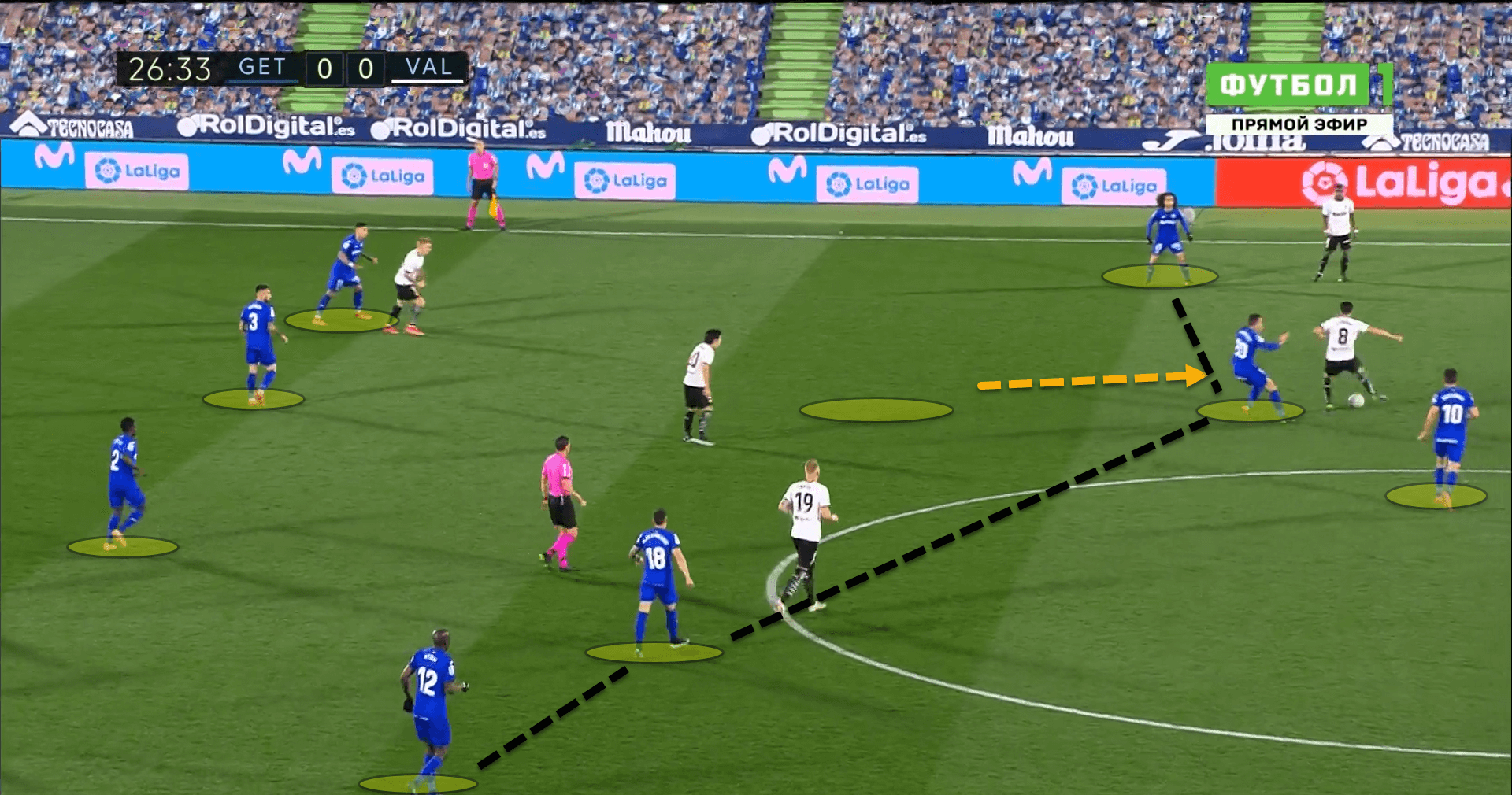
In this scenario, Getafe have remained compact in a zonal 4-4-2 mid-to-low block. Valencia have managed to play inside the block and so Maksimovic has darted out to close down Carlos Soler on the ball to try and regain possession or potentially force him back outside the zonal block.
Valencia deploy a very similar defensive structure although it is noticeably not as well-drilled and players do not engage as willingly as Getafe’s.
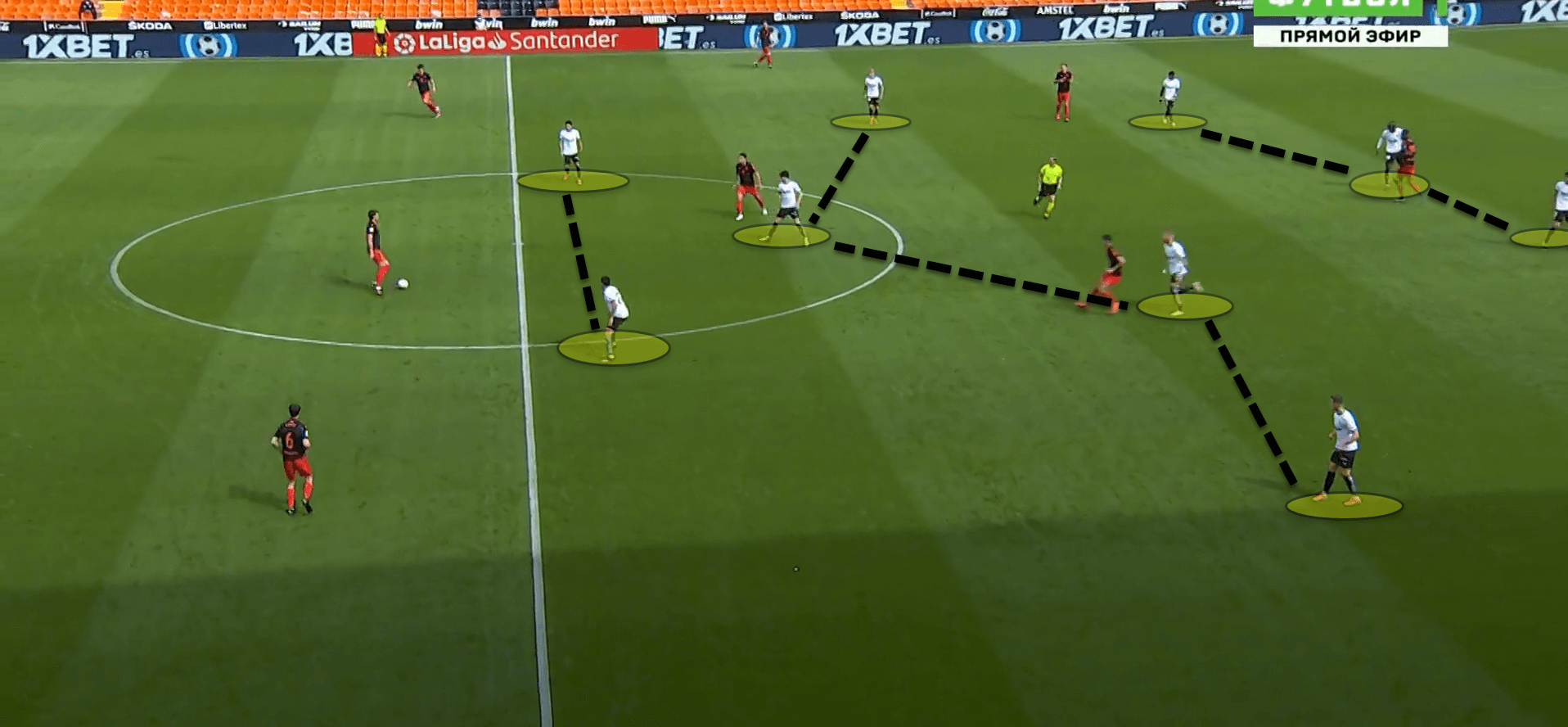
Here, the 4-4-2 zonal block can be seen being deployed by Valencia in a game against Real Sociedad. The aim here is to cut off central passing options and force the opposition wide. When the team in possession manages to play inside the block itself, the nearby players quickly close him down, just as we saw with Maksimovic in the image prior.
Since the Valencia players already have a good idea of how to utilise a defensive structure as such, it may be easier for Bordalás to implement this as he just needs to improve their intensity, tenacity, and reactions.
Providing the new manager can improve Valencia’s defence, a massive uplift in results will possibly be seen as there are far too many times in games where they go behind in games.
Conclusion
Bordalás will hopefully add some much-needed defensive structure to his new side in games and an ability to be more dogged and physical in games.
In a summer where there has already been a massive turnover of managers in the top European leagues, particularly in Italy and Spain, José Bordalás’ appointment at Valencia is one of the most interesting to keep an eye on. The decision could go either incredibly well or terribly wrong, but of course one would hope that it will be the former.






Comments